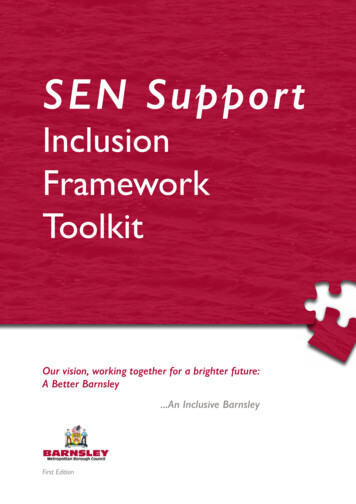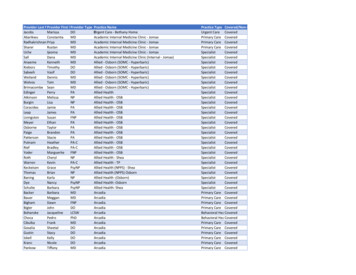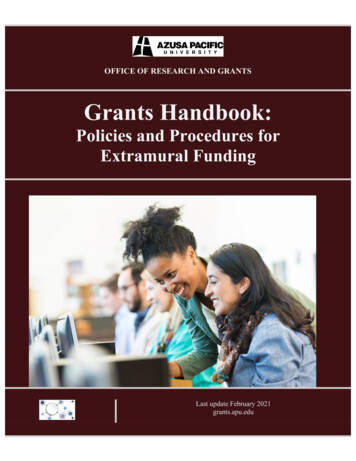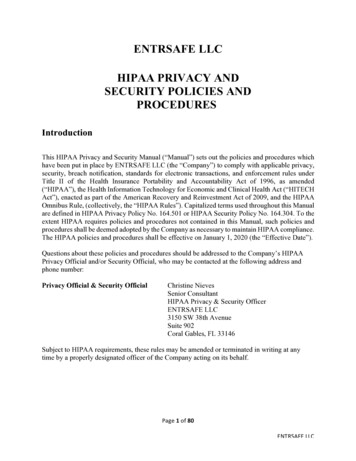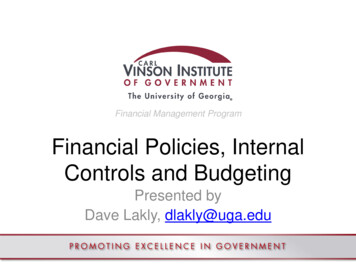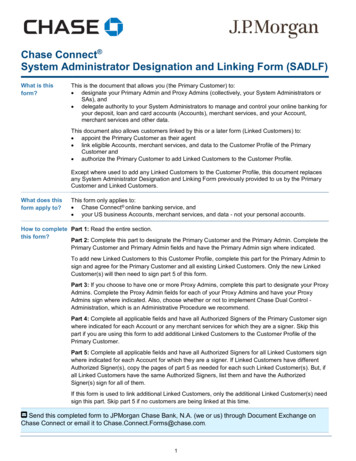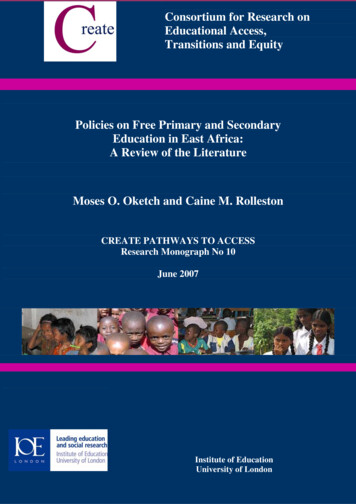
Transcription
Consortium for Research onEducational Access,Transitions and EquityPolicies on Free Primary and SecondaryEducation in East Africa:A Review of the LiteratureMoses O. Oketch and Caine M. RollestonCREATE PATHWAYS TO ACCESSResearch Monograph No 10June 2007Institute of EducationUniversity of London
The Consortium for Educational Access, Transitions and Equity (CREATE) is a Research ProgrammeConsortium supported by the UK Department for International Development (DFID). Its purpose is toundertake research designed to improve access to basic education in developing countries. It seeks to achievethis through generating new knowledge and encouraging its application through effective communication anddissemination to national and international development agencies, national governments, education anddevelopment professionals, non-government organisations and other interested stakeholders.Access to basic education lies at the heart of development. Lack of educational access, and securely acquiredknowledge and skill, is both a part of the definition of poverty, and a means for its diminution. Sustainedaccess to meaningful learning that has value is critical to long term improvements in productivity, thereduction of inter-generational cycles of poverty, demographic transition, preventive health care, theempowerment of women, and reductions in inequality.The CREATE partnersCREATE is developing its research collaboratively with partners in Sub-Saharan Africa and South Asia. Thelead partner of CREATE is the Centre for International Education at the University of Sussex. The partnersare:The Centre for International Education, University of Sussex: Professor Keith M Lewin (Director)The Institute of Education and Development, BRAC University, Dhaka, Bangladesh: Dr Manzoor AhmedThe National University of Educational Planning and Administration, Delhi, India: Professor R GovindaThe Education Policy Unit, University of the Witwatersrand, South Africa: Dr Shireen MotalaThe Universities of Education at Winneba and Cape Coast, Ghana: Professor Jerome DjangmahThe Institute of Education, University of London: Professor Angela W LittleAssociate Partner: The Institute of Development Studies at SussexDisclaimerThe research on which this paper is based was commissioned by the Consortium for Research on EducationalAccess, Transitions and Equity (CREATE http://www.create-rpc.org). CREATE is funded by the UKDepartment for International Development (DFID) for the benefit of developing countries and is coordinatedfrom the Centre for International Education, University of Sussex. The views expressed are those of theauthor(s) and not necessarily those of DFID, the Institute of Education, or the CREATE Team.Copyright CREATE 2007ISBN: 0-901881-22-8Address for correspondence:CREATE,Centre for International Education, Sussex School of Education,University of Sussex, Falmer, Brighton BN1 9QQ,United KingdomTel:Fax:Author Emails:Website:Email: 44 (0) 1273 678464 44 (0) 1273 877534m.oketch@ioe.ac.uk and te@sussex.ac.ukPlease contact CREATE using the details above if you require a hard copy of this publication
Policies on Free Primary and SecondaryEducation in East Africa:A Review of the LiteratureMoses O. Oketch and Caine M. RollestonCREATE PATHWAYS TO ACCESSResearch Monograph No 10June 2007
i
ContentsAcknowledgements.ivPreface.vSummary .vi1. Introduction.12. Immediate Post-Independence Policies on Access .42.1 Formulation of Policies .82.1.1 Kenya .82.1.2 Uganda .132.1.3 Tanzania.152.1.4 Summary .173. Policy Implementation Strategies and Processes.193.1 Kenya.193.2 Uganda.203.3 Tanzania .213.4 Summary.224. Policy Institutionalization, Replicability and Financial Sustainability.244.1 Kenya.244.2 Uganda.264.3 Tanzania .285. Policy impact and implication on poorest groups.306. Policies on Secondary Education Access (CREATE Zone 4) .337. Conclusion and Recommendations for Further Policy Research .36References.38ii
List of AcronymsCREATEConsortium for Research on Educational Access, Transitions and EquityDHSDemographic and Household SurveyEACEast African CommunityEFAEducation for AllESREducation for Self-RelianceFPEFree Primary EducationFDIForeign Direct InvestmentFHSFree High SchoolGERGross Enrolment RateGPIGender Parity IndexIMFInternational Monetary FundKANUKenya African National UnionKPEKenya Preliminary ExaminationLEALocal Education AuthoritiesMDGsMillennium Development GoalsNARCNational Alliance Rainbow CoalitionNAPENational Assessment of Primary EducationNGONon Governmental OrganisationSAPsStructural Adjustment ProgrammesTANUTanganyika African National UnionTAPATanganyika African Parents AssociationTANUTanzania African National UnionUPEUniversal Primary Educationiii
AcknowledgementsComments by Angela Little and Tony Somerset on earlier drafts were helpful. None shareresponsibility for the review. Thanks also to Fran Hunt for editing and Elena Dennisonfor presentation of this report.iv
PrefaceThis research monograph is one of several in the CREATE Pathways to Access Seriesthat address policy formulation and implementation. Specifically it reviews theinternational research literature on the formulation and implementation of policies on freeprimary and secondary education in Kenya, Tanzania and Uganda since independence in1963, 1961 and 1962 respectively. The monograph addresses the origins of these policies,and the increasing role, over time, of the international development community. What arethe politics of policy formulation? How have polices changed over time, and why?In the immediate post independence period policy priority was given to the expansion ofsecondary and tertiary education in all three countries. But it was not long beforecompetitive politics, social demand and faith in the role of education led to active policiesfor Universal Primary Education in the late 1960s and early 1970s in Kenya andTanzania. While initial enrolment gains were rapid, both countries experienced setbackssubsequently. The reasons for this and the greater involvement of the internationalcommunity in recent years are explored. The story of Uganda’s rapid progress towardsUniversal primary education starts much later, in the mid 1990s, in the wake of thetransition to democratic politics. The abolition of fees at different points has been criticalin all three countries in increasing enrolments.Moses Oketch and Caine Rolleston offer an important contribution to our understandingof the underlying determinants of policies for free primary and secondary education, thepatterns of access that follow from specific policies and the undermining of achievementsin the context of economic decline on the one hand and the imposition of fees on theother.Professor Angela W LittleInstitute of Education, LondonCREATE Partner Institute Convenorv
SummaryKenya, Tanzania and Uganda are among the countries in Sub-Saharan Africa which haverecently implemented policies for free primary education, motivated in part by reneweddemocratic accountability following the re-emergence of multi-party politics in the 1990s.However, it is not the first time that the goal of expanding primary education has beenpursued by these three neighbouring countries which have much in common. Since the1960s, they have attempted to expand access at various levels of their education systemsalbeit with differences in philosophy and in both the modes and successes ofimplementation. All three countries continue to face the challenges of enrolling everychild in school, keeping them in school and ensuring that meaningful learning occurs forall enrolled children.This paper provides an a review of the three countries’ policies for expanding access toeducation, particularly with regard to equity and the enrolment of excluded groups sincetheir political independence in the 1960s. It considers policies in the light of thecountries’ own stated goals alongside the broader international agendas set by theMillennium Development Goals and in particular, ‘Education for All’. It is concernedwith the following questions: What led to those policies and how were they funded? Whatwas the role, if any, of the international community in the formulation of those policies?What were the politics and philosophies surrounding the formulation of those policies,have the policies changed over time, and if so how and why? The paper also discusses therange of strategies for implementation adopted.Tremendous growth has occurred in access to primary education since the 1960s, not leastin Kenya, Tanzania and Uganda. The challenge of providing equitable access toschooling has been addressed in a series of education drives with varying motivations,modalities and degrees of success, the most recent of which pays attention to theincreasingly pressing question of the transition to secondary education. The success ofsuch policy remains to be seen but will be crucial for the widening of access to thebenefits of education and to economic opportunity, particularly for those groups whichhistory has so far excluded.vi
Policies on Free Primary and Secondary Education in East Africa:A Review of the Literature1. IntroductionThis paper is written for The Consortium for Research on Educational Access,Transitions and Equity (CREATE) based on the experiences of three East Africancountries in terms of the formulation and implementation of policies around access toprimary and secondary education since their independence in the 1960s. The three EastAfrican countries Kenya, Tanzania and Uganda are often held up as countries in SubSaharan Africa that have succeeded in the implementation of free primary educationwhich is viewed as the first step towards achieving Education for All (EFA) and some ofthe Millennium Development Goals (MDGs). In all three countries the implementation offree primary education (FPE) policy is leading to new policies for access to secondaryeducation and ironically, in the case of Tanzania, to a decline in primary enrolment.Using CREATE’s four ‘zones of exclusion 1 ’, this paper aims to explore the formulationof policies for access to primary and secondary education since the 1960s. The paperaddresses the following questions: What led to the policies and how were they funded?What was the role, if any, of the international community in the formulation of thepolicies? What were the politics and underpinning philosophy surrounding theformulation of the policies and have the policies changed over time, and if so why?The paper also reviews strategies for implementation and considers whether theimplementation involved phasing in by grade or was simultaneous across grades andwhether pilots were used or implementation took place at the national level straight away.Issues including how responsibilities were allocated and how teacher training was carriedout are discussed. A number of matters concerning the implementation process areexplored, including questions of the supply of school places, the level of social andeconomic demand and the presence of possible access inhibitors (including theavailability of facilities). Access indicators such as pupil flows and rates ofretention/dropout, achievement, transition to secondary and participation of excludedgroups are considered. We also explore issues of the institutionalisation, replicability andfinancial sustainability of FPE policies, along with the implications for the poorest groupsand we offer an overview of recent policies on access to secondary education.All three countries have recently implemented policies of FPE. In Uganda, FPE isregarded as having been largely successful in terms of improving access since itsimplementation in 1997 (Ministry of Education and Sports, Uganda, 1999; Deininger,2003; Bategeka, 2005; Al-Samarrai, 2003). In Kenya, enrolment increased by 18 per centfrom 5.9 million children in 2002 to 7.2 million in 2004 following the implementation ofFPE in 2003. The newly elected National Alliance Rainbow Coalition (NARC)Government, which announced and implemented the policy, regards it a success(Republic of Kenya, 2005, p. 39). In Tanzania FPE was announced in 2001 but theprocess has been described by some analysts as being slow and has raised questions as to1CREATE has identified four ‘zones of vulnerability’ which it uses to describe different stages ofeducational access, these are: zone one: children who have never been to school; zone two: children whohave been to school, but have dropped out; zone three: children at risk of dropping out from school andzone four: children who are excluded from lower secondary education despite completing primary.
Free Primary Education in East Africathe Tanzanian Government’s ability to deliver a totally successful universal FPE(Galabawa, 2001) .All three countries have common characteristics and historical backgrounds regardingaccess to education. At all educational levels, access had historically been limited to thefew during the colonial period and hence the three countries faced similar educational andliteracy challenges following political independence in the 1960s. Kenya declared acampaign for Universal Primary Education (UPE) free of charge as a long-term objectivein 1963. Tanzania followed in 1967, and Uganda, although lukewarm in its desire toexpand primary education nonetheless experienced improved access from the time ofindependence in 1962 until the late 1970s when internal political conflict and war causedserious disruption (Bogonko, 1992). All three countries exhibited patterns of exclusionacross the four CREATE zones identified earlier. In more recent years and following there-introduction of multi-party politics in the late 1990s, they have all announced andimplemented new policies for FPE (Stasavage, 2005). The three countries have haddifferent experiences with the implementation of both UPE in the 1960s and FPE in the1990s and have different philosophies underpinning their education expansion moregenerally.Sharing common borders, the three countries came together to form the East AfricanCommunity (EAC), a loose federation as a political vehicle to pursue common goals inthe 1960s. The community broke down in 1977 following philosophical differences intheir development strategies. Tanzania and Uganda followed a socialist model ofdevelopment while Kenya adhered to capitalism in practice (although referred to ‘Africansocialism’ in development strategy policy documents). On being faced with similarchallenges, partly as a result of policies of economic liberalisation under StructuralAdjustment Programmes (SAPs), the EAC was revived in the 1990s to provide a commonplatform from which to address common problems.While FPE is often associated with Jomtien and Dakar conferences of 1990 and 2000which set the current EFA targets, the idea of UPE in the three East African countries istraceable to the 1961 Conference of African States on the Development of Education inAfrica, held in Addis Ababa. The main purpose of the Conference was to provide a forumfor African states gaining independence ‘to decide on their priority educational needs forthe promotion of economic and social development in Africa, and in the light of these, toestablish a first tentative short and long- term plan for educational development in thecontinent, embodying the priorities they had decided upon for the economic growth of theregion’ (UNESCO, 1961: v). Nonetheless, UPE was only set as a long-term goal by theconferences, when resources would permit it to be realized, estimated to be in 1980.Instead in these countries priority was placed on the expansion of secondary and highereducation to meet the required manpower needs, in order to take over the running of thestate from the departing colonial governments. Kenya, Uganda and Tanzania wererepresented at this conference and the educational expansion policies they each ultimatelypursued upon attaining full independence had a semblance of or at least were influencedby the short-term and long-term goals commonly agreed in Addis Ababa.The rest of this paper is organised as follows. First, we discuss policies and action takenin the immediate post-independence era in relation to the CREATE zones of exclusion.Second, we present the formulation of those policies again in relation to the CREATEzones of exclusion. Third, we discuss implementation strategies and the implementation2
Free Primary Education in East Africaprocesses. Fourth, we discuss the institutionalisation, replicability and financialsustainability of these policies. Fifth we outline the implications of these policies for thepoorest groups in line with CREATE’s zones of exclusion. Sixth we provide an overviewof recent policies on access to secondary education in relation to zone four (those studentswho complete primary school, but do not successfully transfer to secondary). A summaryand our recommendations for policy related empirical research follow.3
Free Primary Education in East Africa2. Immediate Post-Independence Policies on AccessIndependence and education were intertwined in all three East African countries.However, they differed on how they emphasised and implemented policies for expandedaccess to education. Tanzania was the first to attain independence in 1961 and JuliusNyerere, the founding president, having been a teacher himself, placed emphasis onsecondary education for the nation’s development. Uganda followed in 1962 and theretoo Milton Obote, the founding president immediately emphasised the need to expandeducation to meet national development needs and priority was given to secondaryeducation. Kenya gained independence a year after Uganda in 1963 and Jomo Kenyatta’sKenya African National Union (KANU) Government did not hesitate to declare educationone of its key priorities for national development with emphasis placed on thedevelopment of secondary and tertiary education. The three countries adhered to theagreed framework set out at the Addis Ababa conference which prioritised the expansionof secondary and tertiary education. This emphasis related to the need to meet keymanpower requirements.Although prioritization of education policy driven by manpower needs immediatelyfollowed independence, the three governments also identified ‘ignorance’ and illiteracy astwo of the problems they needed to tackle through education. This essentially implied anexpansion of primary education. As a consequence access to primary education becamelinked to the notion of development and its provision began to preoccupy the threegovernments. Access had been problematic during colonial administration as there weremany Africans who were simply denied entry to education both for practical and politicalreasons. In practical terms, the rural subsistence economy may have not required peopleto be well educated. In political terms, an educated population may not have served theinterests of the colonial system. Many who managed to gain entry to primary educationcould not continue beyond four years of education because of the Standard IVexamination process. Access to secondary education was extremely limited and thosewho managed to reach it often regarded themselves to be elite Africans. Often they wererewarded with immediate employment in the civil service, an opportunity whichimmediately set them apart from the rest of the population. Given the benefits the peopleof these countries could see from those who had accessed secondary education, thedemand for it became very high. However, access to secondary education required prioraccess to primary education. Thus, the demand for primary education was driven by thebenefits attached to secondary education. Education immediately became an issue ofdisagreement between the Africans and the colonial governments and was used as atheme to fight for political independence. Once independence was attained, expandingaccess to those who had been excluded by the colonial administration became animportant means of gaining full legitimacy and of reassuring people that politicalindependence was not a sham (Bogonko, 1992). A number of policies were pursued tofacilitate rapid access for those who had been excluded.An immediate policy initiative to expand access in the three countries, was the abolitionof racial schooling systems which had existed during the colonial period and thedevelopment of one national education system. However, this action did not expandaccess for the majority who had been excluded because fees remained a barrier. What itdid was to open access to the emerging African political elites who could afford to paythe fees charged in what had been well equipped formerly European-only schools. The4
Free Primary Education in East Africanext step which improved access in Kenya and Tanzania was the abolition of the StandardIV examination, although fees remained a barrier to many poor households. In Ugandathe situation was already better as they had put in place a policy for six years ofuninterrupted primary education and for two-years junior secondary education, which wasopen to all who could pay for it. This had placed Uganda ahead of both Kenya andTanzania in terms of transition to some form of secondary education although in realityvery few managed to go past the six years of primary education (Bogonko, 1992: 24)Tanzania championed the idea of a federal East African country and her leader JuliusNyerere had been willing to delay Tanzania’s attainment of independence by one year ifthis would facilitate the formation of such a community. Kenya and Uganda werehowever lukewarm to the idea and as a result independence was attained by each countryseparately (Southhall, 1974). Still, the spirit of an East African Community remained andthe leaders of the newly independent countries felt that a common education would beinstrumental to the achievement of this goal. Moreover, by the time of independence theonly university available in the region, which was shared by the three countries, was theUniversity of East Africa at Makerere in Uganda. The need to have a uniform educationsystem was therefore one of practical necessity, if the countries were to share theuniversity in an effort to quickly meet their manpower needs. Admission to the universityhad to be based on some agreed uniform or equivalent number of years study in primaryand secondary education. To deal with this problem, Nyerere, Kenyatta and Obote asheads of state in each of the three countries called for a common seven year primaryeducation cycle. Consequently by 1964, Kenya had scrapped the Standard IVexamination and the former primary and intermediate courses were replaced by oneconsolidated seven-year primary course, which was fully implemented in 1966 (Bogonko,1992, p. 24). This resulted in a rapid increase in the number of children proceeding to theKenya Preliminary Examination (KPE) taken at the end of the primary cycle from 62,000in 1964 to 133,000 in 1966 (Kenya, MEARS, 1964-66, 2, 4 cited in Bogonko, 1992, p.24). Uganda also introduced changes leading to the merging of the six year primaryeducation and the two-year junior secondary schooling into one seven year primaryeducation system by 1967. This had a significant impact on access as ‘formerly onlyabout one out of three or four primary-school pupils obtained places in junior secondaryschool’ (Bogonko, 1992:24).Tanzania followed in 1966 when the Standard IV examination was scrapped in towns andthen in rural areas in 1973 (Morrison 1976:271 cited in Bogonko 1992:25). Bogonkoargues that Tanzania’s separate treatment of rural and urban education reflected the scantattention paid to the expansion of primary education to the masses (Bogonko, 1992).Rather, the policy that was openly supported in Tanzania was the expansion of secondaryand tertiary education, which was believed to be more useful for economic developmentthan primary education. Tanzania’s actions seem to have been more in line with therecommendations reached at the 1961 Addis Ababa Conference where expansion ofsecondary education to meet manpower needs was prioritised over access to primaryeducation.The move by Tanzania in 1973 to eliminate the Standard IV examination for the entirenation now meant that all three East African countries had an uninterrupted seven years ofprimary education. This had a significant impact in promoting access and for many oftheir citizens, the benefits of independence were now manifest. The uniform system ofeducation continued in the three countries until Kenya changed its education system to an5
Free Primary Education in East Africaeight year primary, four-year secondary and four-year university education (8 4 4)system in 1984 (Bogonko, 1992: 25).In terms of impact on access and in relation to CREATE’s zones of exclusion, theintegration of the racially-divided schooling system into one national system, along withthe elimination of the Standard IV examination led to improvements in access to primaryeducation for those who had been excluded during the colonial period. Althoughgovernment policy placed an emphasis on the expansion of secondary education formanpower purposes, it was at the primary level ‘where education experienced the mosttremendous and most unprecedented growth of all in terms of both the number of schoolsand of pupils’ (Bogonko, 1992:25). While there was an emphasis by the governments onzone four, reduced exclusion in zones one to three was also achieved.In Kenya, enrolment at primary level increased by 23.3 per cent between 1964 and 1968from 980,849 to 1,209,680. This rose even further such that by 1983 nearly 93 per cent ofschool age pupils were enrolled, up from less than 60 percent in 1963. Enrollment in 1983stood at 4.3 million pupils. The highest rates of growth were witnessed between 1970 and1974 following the announcement that school fees had been abolished. This happenedfirstly in semi-arid areas and for needy cases throughout the country, and then for the firstfour years throughout the country (Bogonko, 1992:25; Buchmann, 2001).Tanzania followed suit in 1969 in response to the pressure from local community leadersand Tanganyika African National Union (TANU) leaders to expand access. Expansion ofgovernment-aided primary schools had previously been restricted by government policywhich placed an emphasis on secondary education. The only significant expansion ofaccess that was allowed following pressure by political and community leaders was thatof unaided schools. The decision to restrict government expansion of primary educationseriously affected access. It was Neyerere’s speech during the launch of the secondNational Development Plan (1969-74) in which he lamented low levels of primaryenrolment in Tanzania as ‘unacceptable to a country which claims to be buildingsocialism’ that triggered a change in policy which saw Tanzania achieve universalprimary education in 1977 (Bogonko, 1992).Uganda also attempted to expand access to education for its citizens but achievementswere fewer than in Kenya and Tanzania. Between 1964 and 1982, primary-schoolenrolment in Uganda rose by only 166 per cent. During the same period, thecorresponding increases in Kenya and Tanzania were 327 per cent (from 980,849 to4,184,602) and 523 per cent (from 633,678 to 3,312,799) respectively. In the 1970s, theannual average growth of primary-school pupils was 6 per cent for Uganda, 12 per centfor Kenya and 16 per cent for Tanzania (Bogonko, 1992: 27-28; also see Ssekamwa &Lugumba, 2001). The need to overhaul colonial policies and to expand educational accessfelt so strongly in Kenya (and to a lesser extent in Tanzania) was much weaker inUganda. The presence of a substantial white-settler community in Kenya meant thatcontrol of the schools was sharply contested during the colonial period,
Centre for International Education, Sussex School of Education, University of Sussex, Falmer, Brighton BN1 9QQ, United Kingdom Tel: 44 (0) 1273 678464 Fax: 44 (0) 1273 877534 . (Ministry of Education and Sports, Uganda, 1999; Deininger, 2003; Bategeka, 2005; Al-Samarrai, 2003). In Kenya, enrolment increased by 18 per cent



